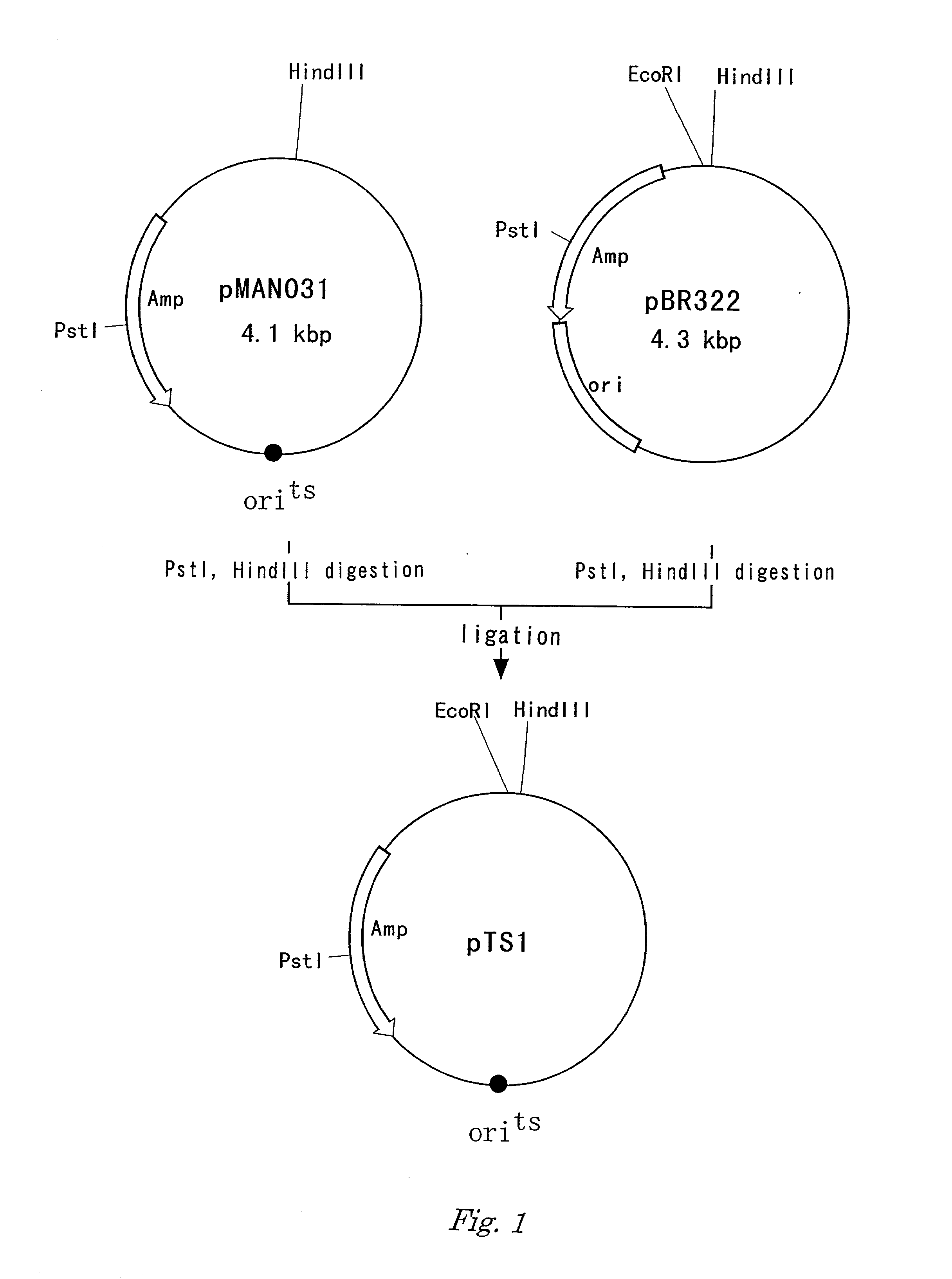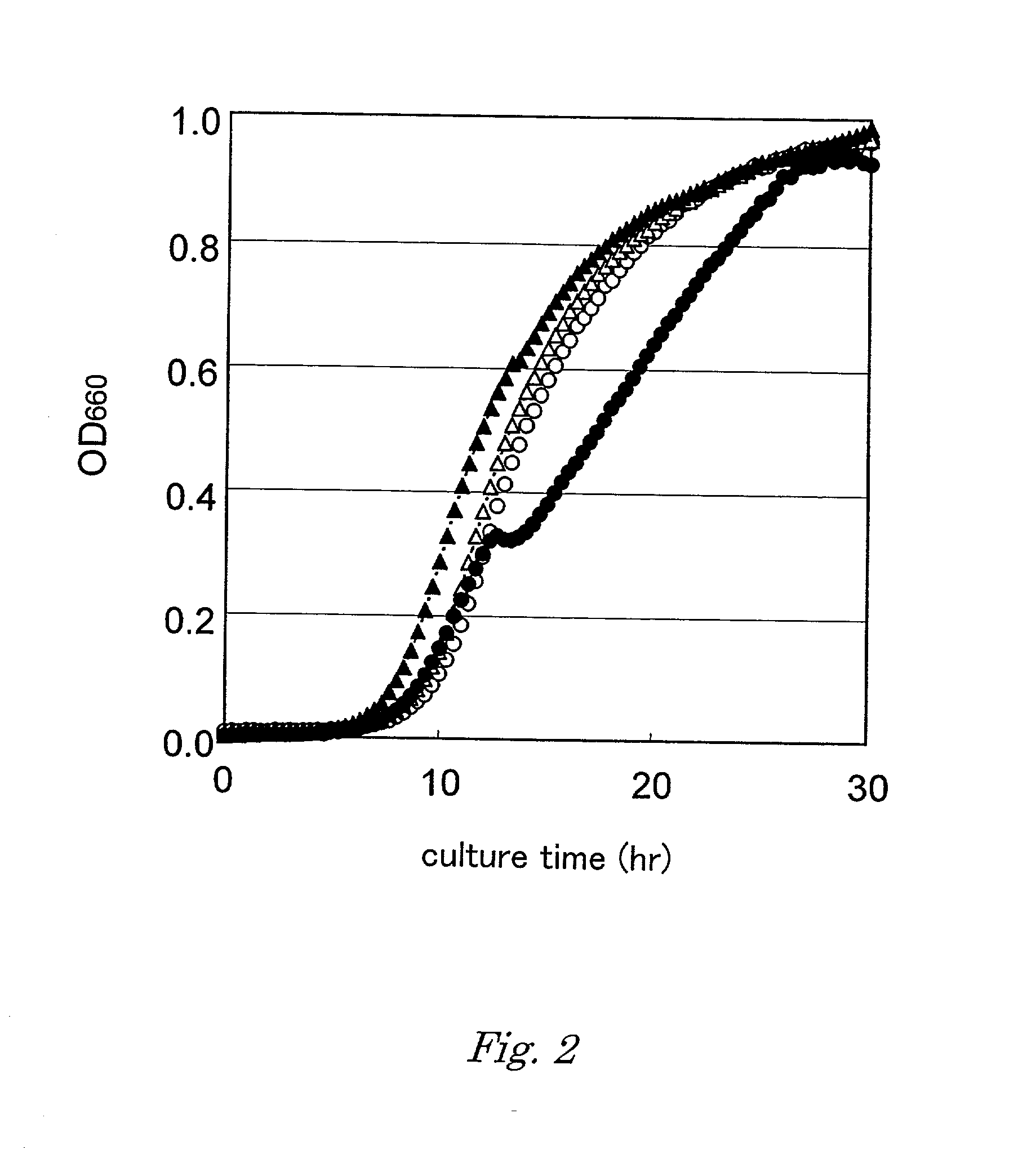Method for producing target substance by fermentation
a technology of target substance and fermentation method, which is applied in the direction of biochemistry apparatus and processes, peptides, etc., can solve the problems of ineffective utility cost and so on, vain assimilation of oligosaccharides such as maltose, and the inability of mutant strains to assimilate maltose simultaneously in the presence of glucose, so as to improve the assimilation ability of microorganisms
- Summary
- Abstract
- Description
- Claims
- Application Information
AI Technical Summary
Benefits of technology
Problems solved by technology
Method used
Image
Examples
example 1
Introduction of Mutation into MalK Gene and Confirmation of Improvement in Maltose Assimilation Property
[0056] A colony of E. coli W3100 was inoculated into 5 ml of L medium and cultured overnight with shaking. From the obtained cells, chromosomal DNA was prepared by using Wizard Genomic DNA Purification Kit (Promega). PCR was performed by using the above chromosomal DNA as a template and the primers shown below.
7 [Primer 1] 5'-GGCGGTAATGTGGAGATGCGCACATAAAATCGCC (SEQ ID NO:1) -3' [Primer 2] 5'-CCTGAGTCATTGCTTTTCTTTTTTCACATCACCT (SEQ ID NO:2) GTGAC-3'
[0057] PCR was performed by using Pyrobest DNA Polymerase produced by Takara Shuzo and according to the protocol attached to the enzyme. After completion of the reaction, the amplification product was blunt-ended and phosphorylated by using BKL Kit produced by Takara Shuzo. The amplified fragment was ligated by using Ligation Kit ver.2 (Takara Shuzo) to pSTV28 (Takara Shuzo) treated with a restriction enzyme Sma I (Takara Shuzo) and then...
example 2
Introduction of Mutation into crr Gene and Confirmation of Improvement in Maltose Assimilation Property
[0066] In this example, it was decided to introduce a mutation into the crr gene in order to reduce the interaction between the MalK protein and the crr gene product, IIA.sup.Glc.
[0067] A colony of E. coli W3100 was inoculated into 5 ml of L medium and cultured overnight with shaking. From the obtained cells, chromosomal DNA was prepared by using Wizard Genomic DNA Purification Kit (Promega). PCR was performed by using the above chromosomal DNA as a template and the primers shown below.
[0068] [Primer 5]
[0069] 5'-GATTTCTTTAGTATCGGCACCAATGATTTAACGC-3' (SEQ ID NO: 5)
[0070] [Primer 6]
[0071] 5'-AAATTGCCGCGATCTAGACAGTGCCATTGC-3' (SEQ ID NO: 6)
[0072] PCR was performed by using Pyrobest DNA Polymerase produced by Takara Shuzo and according to the protocol attached to the enzyme. After completion of the reaction, the amplification product in the reaction mixture was blunt-ended and phosphor...
example 3
Acquisition of Glucose Analogue-Resistant Strain, Identification of Mutation Point of the Resistant Strain and Introduction of the Mutation into E. coli W3100 (tyrA)
[0079] A colony of E. coli W3100 (tyrA) was inoculated into 5 ml of L medium contained in a test tube and cultured overnight with shaking. The cultured cells were washed twice with 5 ml of physiological saline and suspended in the same volume of physiological saline. This suspension was applied in an amount of 0.1 ml to M9 agar medium containing maltose as a carbon source and the surface was dried. One platinum loop of 2-deoxyglucose was placed on the plate, and the cells were cultured at 37.degree. C. for two or three days. E. coli W3100 (tyrA) can utilize maltose as a carbon source, but if a glucose analogue such as 2-deoxyglucose exists, it suffers from the repression and becomes unable to grow. In this case, a growth inhibition circle is formed around the point where the glucose analogue is placed as the center. If c...
PUM
| Property | Measurement | Unit |
|---|---|---|
| temperature | aaaaa | aaaaa |
| pH | aaaaa | aaaaa |
| volume | aaaaa | aaaaa |
Abstract
Description
Claims
Application Information
 Login to View More
Login to View More - R&D
- Intellectual Property
- Life Sciences
- Materials
- Tech Scout
- Unparalleled Data Quality
- Higher Quality Content
- 60% Fewer Hallucinations
Browse by: Latest US Patents, China's latest patents, Technical Efficacy Thesaurus, Application Domain, Technology Topic, Popular Technical Reports.
© 2025 PatSnap. All rights reserved.Legal|Privacy policy|Modern Slavery Act Transparency Statement|Sitemap|About US| Contact US: help@patsnap.com



